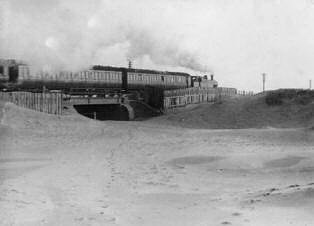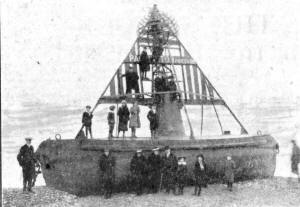|
GALE AND STORM.
WEEK OF WILD WEATHER.
DAMAGE ALONG THE FYLDE COAST.
The storm which swept the coast last weekend wrought considerable
havoc all along the Fylde seaboard, and it will be memorable for the heavy rains by which it was
accompanied. Hundreds of pounds damage to property was done, and traffic was disorganised for a
day and a half.
But in spite of the severity of the storm, the velocity of the wind
on Friday evening was not so high as many people imagined, and in many cases it has been
exceeded in storms in recent years. The highest velocity registered on Friday was sixty miles an
hour, while in a storm last winter the wind blew at over seventy miles an hour. From seven
o'clock on Friday evening until five o'clock on Saturday morning, the wind maintained the speed
of between fifty and sixty miles an hour. On Thursday the highest gust recorded was forty-eight
miles an hour.
ST. ANNES.
At St. Annes all telephonic and telegraphic communication with the
outer world was cut off for a time. Great drifts of sand blocked the railway at South Shore,
some of the drifts being six and eight feet deep. The motor-rail service was entirely suspended
during Saturday, and passengers from inland towns to St. Annes, Ansdell and Lytham, had to
change at Kirkham and be brought forward by a local relief train. All passengers between St.
Annes and Blackpool had to travel via Kirkham. Gangs of Men were employed in clearing the
sand, but it was not until Sunday afternoon that the service was resumed. Traffic on the
Blackpool, St. Annes and Lytham Tramway was disorganised on Friday evening, owing to the over
head wires breaking.

Sand drifts along the railway at
Blackpool in 1914.
Chimneys, slates and ridge tiles were dislodged in many parts of the
town. At the corner or Lightburne Avenue and South Promenade the entire chimney of a house
crashed through the roof and smashed the purlings, doing damage to the extent of many pounds. A
portion of the chimney stack at Mrs. Wade's, St. Andrew's Road South was blown down. Six
plate-glass windows were blown in—three at Messrs. Gill and Read's, and one each at Boots,
Julietts, and Cookson's. Yet at the Pier, where the full force of the gale was felt, not an inch
of glass was broken, the only damage being the lifting of some lead sheeting. Part of the
scaffolding on the additions to the Imperial Hydro was blown down and other damage down. Great
quantities of sand were again blown over the Promenade onto the Esplanade Gardens. An electric
light standard in St. Annes Road West, near the Pier, was blown down.

The Packington buoy, high & dry at St.Annes in 1914.
Fortunately the tides were not high so that there were no
inundations by the sea. But the seas ran high, and two of the big buoys; which mark the Ribble
channel broke loose from their moorings and came ashore at St.Annes. The Packington buoy,
somewhat similar to the Nelson buoy in shape and size, was cast ashore near Fort William, and
Salter's buoy was washed up opposite East Bank Road. Part of the high wooden fence on the
westerly side of the Clifton Park Racecourse was also smashed.
BLACKPOOL.
At Blackpool there was also considerable damage to property. Chimney
stacks, ventilators, windows, window blinds, and advertisement hoardings, were the principal
victims of the gale. The gale also caused a stoppage of the Promenade tramway service and some
of the tramway men did not get their cars back to the depot until after 2-0 o'clock on Saturday
morning, while others were out even longer. Part of the glass roof over the main platform at
Talbot Road, Station was broken by the fury of the wind, and fell with a great clatter on to the
platform, but fortunately no one was hit. An alarming incident was the blowing, down of a
portion of a large advertisement hoarding in Whitegate Drive whilst a motor-car was passing.
Some of the wood crashed on the car, but the occupants were not injured.
Three of the older houses in Hawes Side Lane suffered rather
seriously, the front walls giving way, causing considerable harm to the inhabitants, while some
premises in Back Dean Street, South Shore, were also damaged.
FLEETWOOD.
Fleetwood escaped luckily, for with the exception of a few slates
being dislodged, no damage was done to property, and no casualties to shipping were
reported.
The "Duke of Cumberland," from Belfast to Fleetwood, on Friday
night, had a very rough passage. Heavy and continuous seas broke over her, and she did not
arrive in Fleetwood until after 8-0 o'clock on Saturday morning. When the vessel was west of
Lune Buoy, she felt the full force of the gale. The bridge end telegraph to the engine-rooms was
swept away, the panels of the fan-room were smashed in by the waves, and the top of the capstan
was wrenched off and sent through the rails. The steerage was flooded; and the passengers had to
leave their quarters. Owing to the strong wind, it was impossible to reach the saloon.
The "Duke of Cornwall,"- on her outward journey from Fleetwood to
Belfast the same night, also experienced the full force of the gale during most of the passage.
Tremendous seas swept over her, and seats in the after-part of the saloon and in the poop were
wrenched from their fastenings, and thrown against the rails with considerable violence,
smashing them in several places. The "Cornwall"' arrived back at Fleetwood On Sunday morning, in
good time, without encountering any further mishap. The damage to both Steamers is being
repaired in Fleetwood.
The crews of the trawlers which arrived during, the week-end
reported having experienced very rough weather, but fortunately no damage was sustained by any
of them.
The rough weather had a disastrous effect on the fishing industry.
The supplies at Fleetwood during the week-end were very meagre, and famine prices ruled.
|